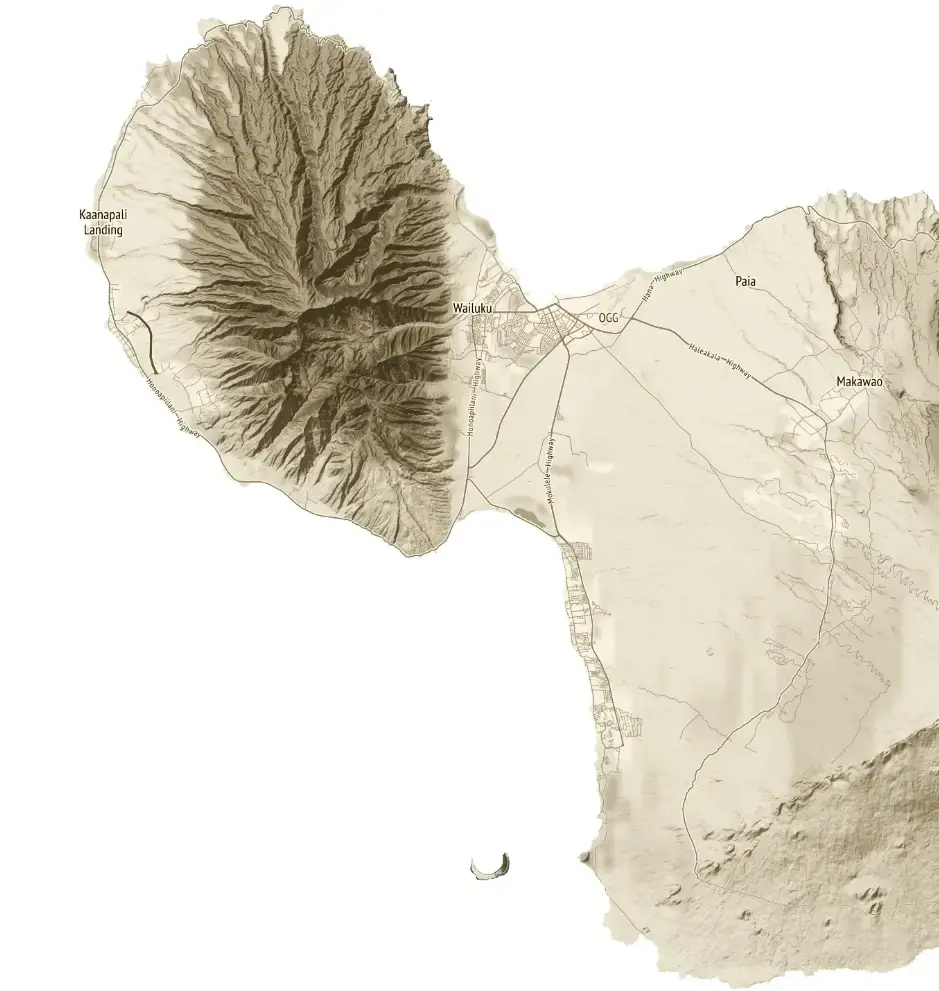Looking for an Awesome Maui Snorkel Tour?
Important Info To Know
Snorkeling
Safety Tips
Snorkeling is one of the most amazing activities that you and your family will enjoy while vacationing in Maui.
To ensure that you get the most out of your snorkeling experience, we’ve compiled the Best Snorkeling Safety Tips to optimize your snorkeling adventures on Maui.
Snorkeling
safety tips
It is true, Maui’s ocean waters are often pleasantly warm and calm, offering amazing swimming and snorkeling opportunities. However, Native Hawaiians have a phrase Mai huli`oe i kokua o ke kai which translates to “never turn your back on the ocean!”
This is a common phrase used by all who live on the Hawaiian Islands. This is because ocean conditions change quickly and a set of waves can sneak up on you from nowhere. Large surf, strong currents, and rogue waves can be dangerous when you are not paying attention.
To remain safe while snorkeling on Maui, visitors need to understand that it’s okay to relax, but never let your guard down. It is common for a snorkeler to be floating along safely through a small set of waves and then suddenly out of nowhere a big wave will sneak up.
Large waves can take down a snorkeler who is not paying attention. Due to this, it’s important always to remember to keep your eyes on the ocean. As long as you never turn your back on the ocean, you can act accordingly and remain safe while snorkeling on Maui.
Surf conditions can affect your overall snorkeling experience. This is especially true for beginners. It is vital that you avoid areas with large surf when searching for a snorkel spot. Also, waves that break close to the shore can make entry and exit very difficult.
Check out the local surf report to find out where the swells are going to break. This way you can make sure to stay away from areas that are expecting large surf.
Remember, the ocean can be unpredictable, so always stay aware of your surroundings and never turn your back to the ocean! If you are unsure, ask someone before entering the ocean. If there is no one around to ask, don’t take unnecessary risks. It’s always better to be safe than sorry!
Some people are prone to motion sickness while snorkeling. If you know that you’re one of these people, there are ways to help prevent the arrival of symptoms. Keep in mind that these preventions do not work for everyone, but they are worth a try. First, avoid alcohol consumption before or during snorkeling and getting on a boat for a snorkel tour. Also, do not overeat before snorkeling, as this can lead to stomach acid. If you are going on a snorkel tour, arrive early to ensure that you will be one of the first to board. If your boat has an engine, pick a seat that is the furthest from the exhaust fumes.
Also, avoid sitting in the cabin portion of the boat. It is best to remain on deck, as fresh air is better for those who are prone to motion sickness.
Some wristbands apply pressure to key pressure points to prevent motion sickness. You can also check with your physician about over the counter medications that can be taken. Some of these include Benadryl, Dramamine, and Meclizine. Make sure to read the label before taking to assure that you give yourself enough time for the drugs to take effect.
If you want to take a more natural route, fresh Hawaiian ginger or ginger pills have been known to settle the stomach. Hawaiian ginger pills can be found at many health food stores in Maui. Keep in mind, most over the counter motion sickness medications cause drowsiness and cannot be combined with alcohol.
If you are not a strong swimmer and are planning on snorkeling over coral heads, please consider using a flotation device under your chest. These really help snorkelers to clear shallow reefs without harm. Remember, if your mask needs adjustment, please swim to the nearest sandy or coral free shallow area to stand.
It is always best to enter the water with a dry face and a dry mask, as this assures a proper seal. Also, try not to breath inside your mask, as this can break your seal. Do your best not to take your mask off at all during your snorkel adventure to keep your seal intact.
Still, there are times that you will need to take your mask off. If your mask starts to fog up during your snorkel excursion, remove the mask and spit in it.
Make sure that you coat the mask without using your fingers. If you don’t have enough spit, add some ocean water and swirl around, pour out and put the mask back on. Most of the time this will take care of defogging your mask.
To clear any water from your snorkel, you will want to swim towards the surface, with you snorkel above water, blow a quick blast of air through the snorkel while saying the word, “two.” This will clear the breathing tube of any water.
Pacing is one of the most important parts of snorkeling safety. When you’re a beginner, it’s easy to get excited and accidentally overextend yourself.
Always keep in mind that the distance that you are swimming out, you must swim eventually that same length back. You do not want to find yourself miles out and realize you’ve become overtired.
It’s also a good idea to keep an eye on the water conditions. Different times of the day can change the ocean currents, and the swells can change throughout the day.
Always give yourself extra time to return to shore. In case of currents changing, you may need more energy to return to the shore. Most importantly, never take risks that will change an awesome snorkeling session into a scary vacation nightmare. Take your time, know your limits and avoid exhaustion by pacing yourself.
Snorkeling is an excellent way to view marine animals in their natural habitat. You may see a honu (Hawaiian green sea turtle) cleaning station, dolphins spinning in midair, and Hawaiian monk seals basking in the sun on nearby rocks. In season, you may also see North Pacific humpback whales breaching off into the distance.
When viewing any of these magnificent marine creatures, please be sure that it is from a safe and respectful distance. Close encounters with humans can cause undue stress.
The NOAA (National Oceanic and Atmospheric Administration) marine life viewing guidelines are as follows: for whales, the legal viewing distance is 100 yards (the length of a football field) for dolphins and monk seals the minimum recommended distance is 50 yards.
Department of Land and Natural Resources recommends keeping a 6-to-10-foot buffer when viewing honu (Hawaiian green sea turtles).
Please note, it is illegal to touch, harm or feed any of the marine animals you may encounter while snorkeling on Maui. If a marine animal swims towards you, it is important to stay out of their way. Many fish, invertebrates, seagrasses, and corals are also protected under the ESA (Endangered Species Act). This makes it illegal to touch, kill or harm any of these species while snorkeling.
The best rules to remember while snorkeling on Maui are, “look but don’t touch,” and “keep your hands to yourself.” These will ensure your safety as well as Maui’s marine animals.
We reiterate, The Marine Mammal Protection Act prohibits the feeding or attempting to feed any of Hawaii’s Marine Mammals in the wild. These activities are illegal because feeding causes harm. It changes their natural wariness of humans and boats.
It also changes their natural behaviors, making them less willing to forage for their own food. This law also protects you from injury from marine mammals who become aggressive and bite because they are seeking or expecting food.
The same goes for feeding the fish. Although it may sound like fun, the long-term impact is a dramatic shift in the reef dynamic. It also causes the fish to become aggressive and encourages them to push smaller, weaker fish species out of the feeding area.
It is important to avoid doing anything that interferes with the natural ecosystem of the creatures who depend on Maui’s reefs as their home.
Hawaii’s coral reefs are very important to its ecosystem. The reefs protect Hawaii’s coastlines from waves, strong currents, and storms. In the ancient Hawaiian language, there is a sacred phrase, Ola na; papa i pulama ‘ia which translates to “cherish the living reefs.”
There are over 150 species of corals that grow on the reefs in Hawaii. Twenty-five percent of these amazing species are endemic to Hawaii. The reefs offer shelter and protection for many of Hawaii’s diverse species. Please don’t ever stand or walk on coral, as it kills the living polyps that are the builders of reef structures. It’s also important to remember that by simply touching the coral, the oils from your hand can cause the death of an entire colony.
If you are not a strong swimmer and are planning on snorkeling over coral heads, please consider using a flotation device under your chest. These really help snorkelers to clear shallow reefs without harm. Remember, if your mask needs adjustment, please swim to the nearest sandy or coral free shallow area to stand. It takes just one careless mistake to exterminate a whole community of coral. We ask that you please help to Ola na; papa i pulama ‘ia.
Aboard the Pride of Maui we do not allow full face snorkel masks. We made this decision based on our experiences with guest safety, in- water communication, and comfort issues. When we breathe, we produce carbon dioxide. Water activity typically requires more oxygen, sometimes making breathing shallow and fast. When this happens in a closed space, it may be difficult for some to completely push out all of the used air potentially causing a build-up of carbon dioxide.
This may to lead to dizziness, a headache, and worst-case scenario, unconsciousness. This can also occur in standard snorkel tubes that have a poor design. It’s always best to make sure you have quality, correct snorkeling equipment.
It’s essential for snorkelers to avoid strong ocean currents, as swimming against them will tire you out very quickly. Even for a strong swimmer, ocean currents can be tiring and don’t make for a pleasant and peaceful snorkeling experience.
However, if you do find yourself caught in a strong current, the most important thing to remember is, don’t panic! The best and quickest way to get out of a current is to swim perpendicular to the current and not to try to swim against it.
Though East and North Maui offer some hot snorkeling spots, keep in mind that these particular areas usually have a constant swell and current activity. These areas can also have some dangerous waves, so it is always important to check out the conditions before entering the water. A good rule to follow is, “If in doubt, stay out!”
First, and most importantly, always check the weather conditions before venturing out to snorkel anywhere on Maui. Keep in mind that Maui’s beaches are susceptible to big waves and hazardous conditions. It is important to assess the wind, ocean currents, and swell in the area that you are considering. Water clarity is also important to ensure safety. Never snorkel in turbid and/or murky water.
There are webcams located at some of Maui’s snorkel spots that can be accessed online. This is one of the best ways to find out about snorkeling conditions beforehand.
Here, you can find information about where the waves are breaking. Rule of thumb is to stay away from areas where the swell and waves are too large.
If you are planning on taking a snorkel tour, your boat crew will be up- to-date on the weather and water conditions. If the crew deems the weather conditions unsafe to visit certain snorkel spots, rest assured your boat captain will take you to the most optimal snorkel spot on the day of your excursion.
Nothing can take the fun out of your time spent on Maui faster than a sunburn. Especially when you get burned early into your vacation. Not only is it a painful nuisance, but it is also a health issue that should be taken seriously. The best thing to do for a sunburn is to prevent it!
It only takes a short time in the sun unprotected, to obtain a pretty miserable sunburn on Maui. This is because sand reflects up to 25 percent of the sun’s rays, giving visitors an extra dose of UV exposure.
Always wear a broad-spectrum sunscreen of a least SPF 30 and don’t be afraid to apply it generously! You need a thick layer for the sunscreen to be effective.
Keep in mind, Hawaii has recently passed a law prohibiting the use of sunscreens containing chemicals that are contributing to the destruction of the coral reefs and other marine life. This will require visitors to use only sunscreens that are reef safe in Hawaii’s ocean waters by the year 2021. Research and purchase a reef safe sunscreen that’s right for you and your family.
When snorkeling, you’ll undoubtedly find yourself exposed to the direct sun for an extended period. We find the best way to get full coverage while snorkeling is by wearing a rash-guard.
A rash guard is a close-fitting swim/surf top worn over swimwear or with a pair of trunks or a bikini bottom. A rash guard provides SPF protection as well as keeping you warm so you can snorkel comfortably for longer periods of time.
Don’t let a cloudy day fool you. Some of the worst sunburns are acquired on overcast days on Maui. Also, early morning is the best time for snorkeling. Not only are the waters typically calmer in the early morning, but the sun also gets stronger between 10 am and 2 pm.
Even when there are peak conditions, it’s important to remember to never go snorkeling on your own. This is particularly true for beginners who are snorkeling in unknown areas. The safest strategy is the “buddy system.” Keeping a watch on each other can reduce the risk of hidden dangers.
While those partners within the buddy system team are always responsible for their own safety, your buddy is there in case of an occurrence that deems one incapable of delivering self-help.
Using the buddy system allows for assistance in donning equipment. It is also helpful to have a buddy when entering and exiting the water. Remember, children should be paired with a responsible adult and never paired up together.
Most importantly, snorkeling is more enjoyable when you have someone else to share in the adventure! Snorkeling in groups is an excellent way to ensure that you don’t miss out on any new and exciting marine life. Whether it be from the shore or onboard a boat, using the buddy system offers many safety benefits on your snorkeling adventures in Maui.
It’s easy to forget about the time while you’re having fun snorkeling on Maui. Although the water temperatures are warmer on Maui, it’s still important to keep track of prolonged exposure to cooler waters, as this can cause a case of mild hypothermia. Being in the water draws heat away from a person body, so even in Maui’s tropical conditions, mild hypothermia is still a possibility.
It is important to be aware of the early signs of hypothermia before they become a threat to your safety. Hypothermia starts to set in when your body temperature falls below 95 degrees Fahrenheit.
You may first notice that your extremities, such as your hands, feel numb and that your breathing has become shallow. Additional signs to watch out for are: decrease in heart rate, uncontrollable shivering, hallucination, confusion, blue skin and pale lips.
The best rule to follow is if you start to shiver while snorkeling, take a break. You should surface as soon as you start to shiver. Find a comfortable place to warm up in the sun. Also, wearing a thicker rash guard or a wetsuit can help to keep you warm and able to snorkel for longer periods of time.
If you have snorkeled before, you know what a nuisance it is to continually need to take your snorkel out of your mouth to communicate with your snorkel buddy. It is a constant interruption of the flow that can cause you to miss out on some amazing marine life sightings. Using snorkel sign language can save you from this frustration, and it is essential for safety while snorkeling. You and your snorkel buddy must be clear on what your specific signs will be before entering the water.
Here are a few basic hand signs that we think are important to learn before enjoying your snorkel adventures on Maui:
- Stop- Hold hand up.
- Everything is Okay- Okay, in sign language.
- Look-Pointing to an object.
- Problem- Palm down with wobbling hand. Going down (diving)- Thumbs down.
- Slower- Hand out with palm down.
These few simple gestures can be very helpful when you are communicating with each other while underwater. When snorkeling with friends, be creative and come up with your own hand signals to use while snorkeling. Not only does snorkel sign language come in handy, but it will also help keep you safe.
Another important safety tip is to make sure you know your limits. Beginners should not venture farther than they are comfortable from the shore or boat while snorkeling. Many snorkeling escapades start from Maui’s shores. As we mentioned before, when snorkeling from the shore, make sure to check weather conditions and be aware of the currents.
Don’t swim too far offshore; it is easy to forget the time and get distracted by the amazing beauty of Maui’s underwater world, only to look up and realize that you have wandered too far.
While the shore and the boat both provide amazing snorkel adventures, one of the ideal ways to experience snorkeling on Maui is from a boat. Boats have the advantage of being able to quickly transport you to the best and less accessible snorkel spots. Plus, boats offer professional crews that are always there for you to ask questions about your surroundings, the marine life, and to give you helpful tips on snorkeling. Most boats will take care of all the details for you; lunch, drinks, and gear are all included. Still, you don’t want to wander too far off from the boat either. Luckily, the crew is there to give you instructions on the vicinity and time limits. All you need to do is enjoy the adventure!
Having your mask fog up is one of the most frustrating things that can happen while snorkeling. This is a common occurrence in tropical areas like Maui. Fogging is caused by condensation inside your mask. This occurs when the humidity in the air converges with the cooler glass/plastic and forms a moisture layer.
Brand new masks will need the layer of film that is typically applied to the mask during manufacturing. The best way to remove this film is to use an abrasive white toothpaste. (NOTE: this is only for glass lenses, plastic will scratch.) Take a tiny amount of the toothpaste and rub it on both sides in a circular motion, using clean fingers on dry glass lenses.
Rinse and dry with a clean, dry cloth. You may need to repeat this process a few times for optimum results. For plastic lenses, follow the same procedure using a tiny amount of dish soap instead of toothpaste.
Also, you should clean your mask after every use. After cleaning, do not touch the inside. You can use a special anti-fog product to clean your mask, or baby shampoo also works well. Keep in mind; snorkel tours will have taken care of this process for you. On most tours, your snorkel gear is included and will be ready to go when you arrive at your snorkeling destination.
Although snorkeling does not require you to receive any special training, it’s important that you practice safe techniques. It is a good idea to take your time getting comfortable using the equipment. It takes a bit of practice to get used to breathing through the snorkel.
You will spend the majority of your time snorkeling on the water’s surface. However, experienced snorkelers can learn to dive down to see the things they find interesting more closely. Diving requires you to take a deep breath prior because you will not be able to breathe through your snorkel once you are underwater.
The most important thing is to dive down safely, descending slowly, as to equalize your ears by pinching your nose while trying to breathe out through the nose at the same time.
You will also want to slowly return to the surface, again equalizing your ears at intervals. Make sure to blow through your snorkel with a blast of air, while saying the word “two” upon reaching the water’s surface. This will clear your snorkel of any water.
If you are not trained in diving, you do not equalize your ears at intervals on the way down and on the way back up, you can rupture a blood vessel. The best advice is to not dive down too deep below the surface unless you have training, as it can injure your ears.
It’s hard to enjoy your snorkel experience when you are that person who has to keep stopping and fidgeting with your mask. Remember, the rule of thumb is never to take your mask off once you are in the water. Humidity enters the mask as soon as you pull it away from your face, creating condensation.
It is important to find the mask that fits you. To check your mask fit, locate the buckle on both sides. They can be tricky to adjust, as they are made to not slip easily during use. To unlock, pull the tab open. This allows the strap to slide to your specific fit.
When you find your fit, release the tab, and it should lock automatically into position. To help maintain your seal, keep exhaling through your nose to a minimum.
To adjust your snorkel, make sure that the mouthpiece is always on your left side. Put it in your mouth as if you were in the water. Move the plastic clip into the position, meeting the snorkel mask strap. Remove the mask, thread the snorkel clip into the strap, replace the strap into the holding clamp on your mask.
Finally, when you put the mask on, readjust the straps until you have the right fit, adjusting the snorkel’s positioning until it reaches your mouth comfortably.
If this is your first time adjusting a snorkel mask and snorkel, remember that you can always ask for help. If you are on a snorkel tour, the expert crew members are more than happy to help you adjust your mask to ensure an optimum snorkeling experience.
Snorkeling should be an enjoyable and relaxing experience. Remember, if you are a beginner, don’t push yourself too hard. Also, don’t expect to go too far too fast. The best thing you can do is to let yourself ease into snorkeling. Take it easy until you are comfortable and you have gained some experience. The more you snorkel, the more comfortable you will be with snorkeling.
When first starting out, practice in calm waters and choose easy entry points with sandy bottoms. You can even practice using your gear in a swimming pool.
These are great spots to practice putting on your snorkeling gear. Better yet, book a snorkel tour and surround yourself with a boat crew of experts. This way you can always ask questions and seek support when needed.
Also, as a beginner, try to practice snorkeling with someone who has more experience. This is ideal for learning. Ask questions, and this will help you gain knowledge and build the confidence you need. Most importantly, remember to have fun. Snorkeling is one of the most enjoyable excursions you will experience on Maui!
When snorkeling on Maui, it’s always best to find the easiest and safest entry point into the ocean. When entering from the shore, you want to wait and put your fins on at the water’s edge. After you have your fins on, enter the ocean while walking backward, keeping your eyes on the waves.
Also, enter with your mask on your dry face or at least have it around your neck until you are in the water just below chest deep. Once your mask is secure, turn and begin swimming.
When you are exiting onto the beach, snorkel as close to the shore as you can. Look for a calm, sandy area where can easily kneel. Remove your fins while kneeling and wait for the waves to pass by. When you can, stand up and walk out of the ocean, remembering to never take your eyes off of the waves.
Extreme caution is needed when entering from a rocky shoreline. Avoid walking on rocks to prevent falls, as rocks can be very slippery, unstable and sharp. If you must enter over rocks, it is highly recommended that you wear reef booties and carry your fins until you are safely in the water.
On a snorkel tour, the entrance into the water from the boat is very easy. Also, the crew is always there to answer any questions you may have.
Snorkeling Safety
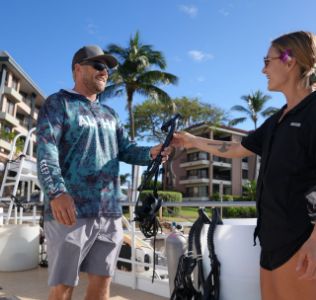
Masks
A snorkeling mask must fit your face and function properly.
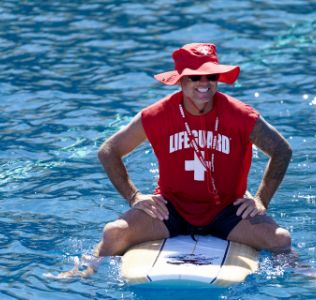
Conditions
Rest assured, weather and ocean conditions are carefully monitored by our expert captain and crew.
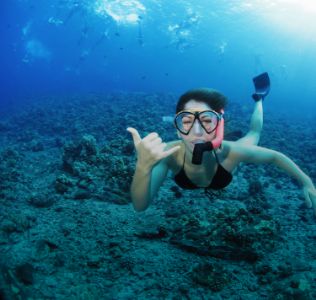
Sign language
Learn snorkeling sign language to point out a turtle to your buddy, ask for help with gear, and more.
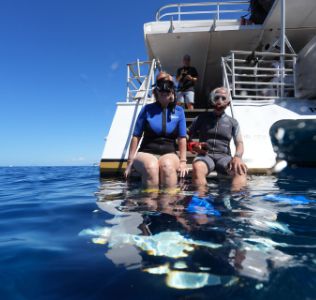
Snorkel with
a buddy
Make sure to always snorkel with a buddy to stay safe and have the best experience in the ocean.
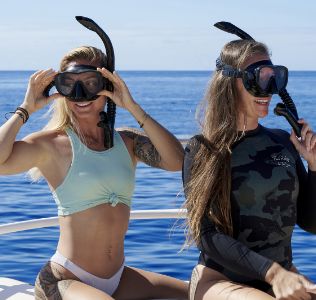
Defog
Your Mask
Defog your mask underwater or prepare your mask to keep from fogging before you enter the water.
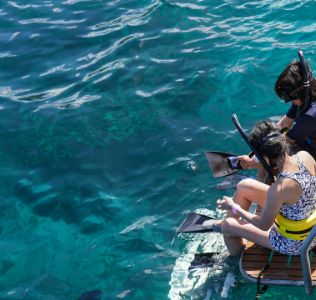
Water
Entry
Learn how to safely lower yourself into the water from the deck of our boat.
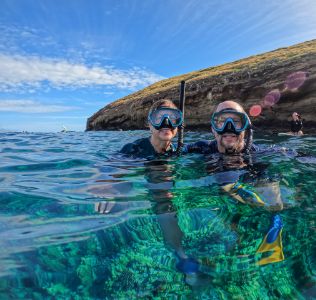
Waves
Calm waters are ideal for snorkeling. When the waves are smaller, you’ll be safer and have more fun.
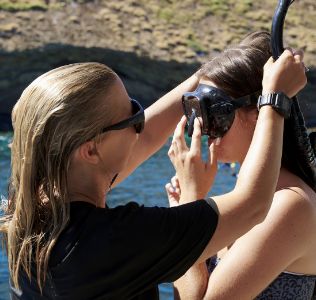
Adjusting Masks
Simple adjustments to a snorkel mask will help with comfort and better underwater vision.

Motion Sickness Precautions
It’s easier to take precautions to prevent motion sickness before it happens, rather than try to alleviate it after it starts.

Never Turn
Your Back
The Golden Rule of all ocean play is to never to turn your back to the ocean!
FAQ
Yes, snorkels are safe for children. On all of our snorkel tours, we offer a free introduction to snorkeling class to teach you ocean safety protocols, how to establish your comfort level, and the correct use of all snorkeling gear.
Pretty much everyone can snorkel. Guests who are pregnant or have health contraindications should get written approval from their doctors before snorkeling.
Snorkeling is safe with proper instruction, knowledge of the ocean, and safety measures in place. Make sure to choose a top-rated and certified snorkel tour operator in Maui.
We do not suggest that guests night snorkel in Maui. Not only is it safest to snorkel during daytime hours, but the best snorkeling experiences are from 10 am to 2 pm. During these hours, the sun is at its highest point, the ocean is at its calmest, and the water clarity is at its best. We only offer morning and afternoon snorkel tours.
Unfortunately, motion sickness can happen in any moving vehicle! Concerned guests might want to take a Dramamine or a natural motion sickness supplement before venturing out to sea on our tour. Ginger works wonders, and ginger pills can be found at any health store on Maui. If you have motion sickness while onboard, you can ask our bartender or a crew member for a fresh ginger drink to calm your stomach. Focusing your gaze on the horizon is also a great trick.
No. We regularly have guests who do not know how to swim. We have several different flotation devices to keep you floating, and we have a lifeguard in the water and crew standing watch.
We are the #1 rated Maui snorkel tour operator for many reasons, not the least of which is that our top priority is always your safety. All of our tours are guided by an expert and certified crew who will instruct you on how to correctly use our state-of-the-art equipment and safely explore the ocean. Our ocean activity instruction will also cover underwater signals and marine life education. Time and again, we are the ideal choice for all snorkel tours in Maui.

Where We Will Snorkel
Visit Maui’s top snorkeling destinations like:

